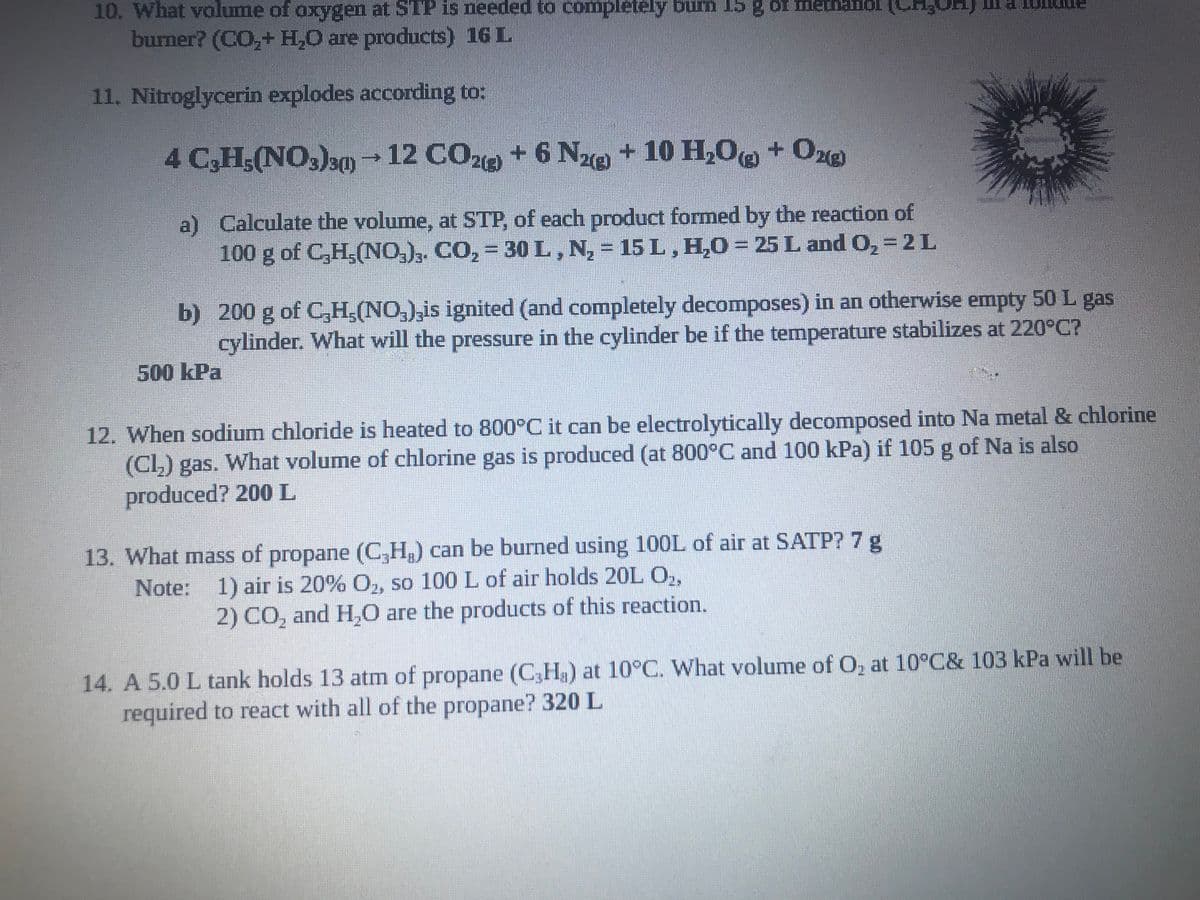Chemistry: An Atoms First Approach
2nd Edition
ISBN:9781305079243
Author:Steven S. Zumdahl, Susan A. Zumdahl
Publisher:Steven S. Zumdahl, Susan A. Zumdahl
Chapter8: Gases
Section: Chapter Questions
Problem 130AE
Related questions
Question

Transcribed Image Text:10. What volume of oxygen at STP is needed to completely burn 15 g of methanol (CH₂
burner? (CO₂+ H₂O are products) 16 L
11. Nitroglycerin explodes according to:
4 C3H5(NO3)3(1)→ 12 CO2(g) + 6 N2 + 10 H₂O + O2(g)
Z
a) Calculate the volume, at STP, of each product formed by the reaction of
100 g of C,H,(NO3)3. CO₂ = 30 L, N₂ = 15 L, H₂O = 25 L and O₂ = 2 L
b) 200 g of C,H,(NO₂),is ignited (and completely decomposes) in an otherwise empty 50 L gas
cylinder. What will the pressure in the cylinder be if the temperature stabilizes at 220°C?
500 kPa
12. When sodium chloride is heated to 800°C it can be electrolytically decomposed into Na metal & chlorine
(Cl₂) gas. What volume of chlorine gas is produced (at 800°C and 100 kPa) if 105 g of Na is also
produced? 200 L
13. What mass of propane (C₂H₂) can be burned using 100L of air at SATP? 7 g
Note: 1) air is 20% O₂, so 100 L of air holds 20L O₂,
2) CO₂ and H₂O are the products of this reaction.
14. A 5.0 L tank holds 13 atm of propane (C3Ha) at 10°C. What volume of O₂ at 10°C& 103 kPa will be
required to react with all of the propane? 320 L
Expert Solution
This question has been solved!
Explore an expertly crafted, step-by-step solution for a thorough understanding of key concepts.
Step by step
Solved in 4 steps

Knowledge Booster
Learn more about
Need a deep-dive on the concept behind this application? Look no further. Learn more about this topic, chemistry and related others by exploring similar questions and additional content below.Recommended textbooks for you

Chemistry: An Atoms First Approach
Chemistry
ISBN:
9781305079243
Author:
Steven S. Zumdahl, Susan A. Zumdahl
Publisher:
Cengage Learning


Chemistry
Chemistry
ISBN:
9781305957404
Author:
Steven S. Zumdahl, Susan A. Zumdahl, Donald J. DeCoste
Publisher:
Cengage Learning

Chemistry: An Atoms First Approach
Chemistry
ISBN:
9781305079243
Author:
Steven S. Zumdahl, Susan A. Zumdahl
Publisher:
Cengage Learning


Chemistry
Chemistry
ISBN:
9781305957404
Author:
Steven S. Zumdahl, Susan A. Zumdahl, Donald J. DeCoste
Publisher:
Cengage Learning

Chemistry for Engineering Students
Chemistry
ISBN:
9781337398909
Author:
Lawrence S. Brown, Tom Holme
Publisher:
Cengage Learning

Introduction to General, Organic and Biochemistry
Chemistry
ISBN:
9781285869759
Author:
Frederick A. Bettelheim, William H. Brown, Mary K. Campbell, Shawn O. Farrell, Omar Torres
Publisher:
Cengage Learning

General Chemistry - Standalone book (MindTap Cour…
Chemistry
ISBN:
9781305580343
Author:
Steven D. Gammon, Ebbing, Darrell Ebbing, Steven D., Darrell; Gammon, Darrell Ebbing; Steven D. Gammon, Darrell D.; Gammon, Ebbing; Steven D. Gammon; Darrell
Publisher:
Cengage Learning